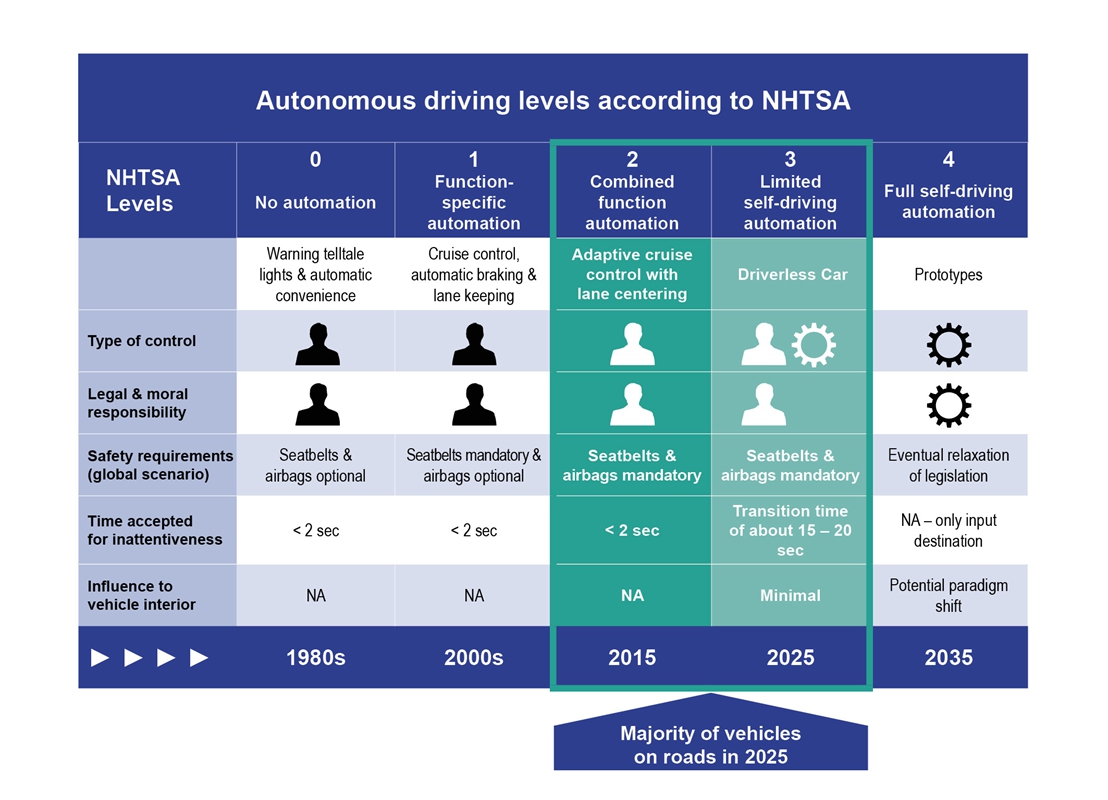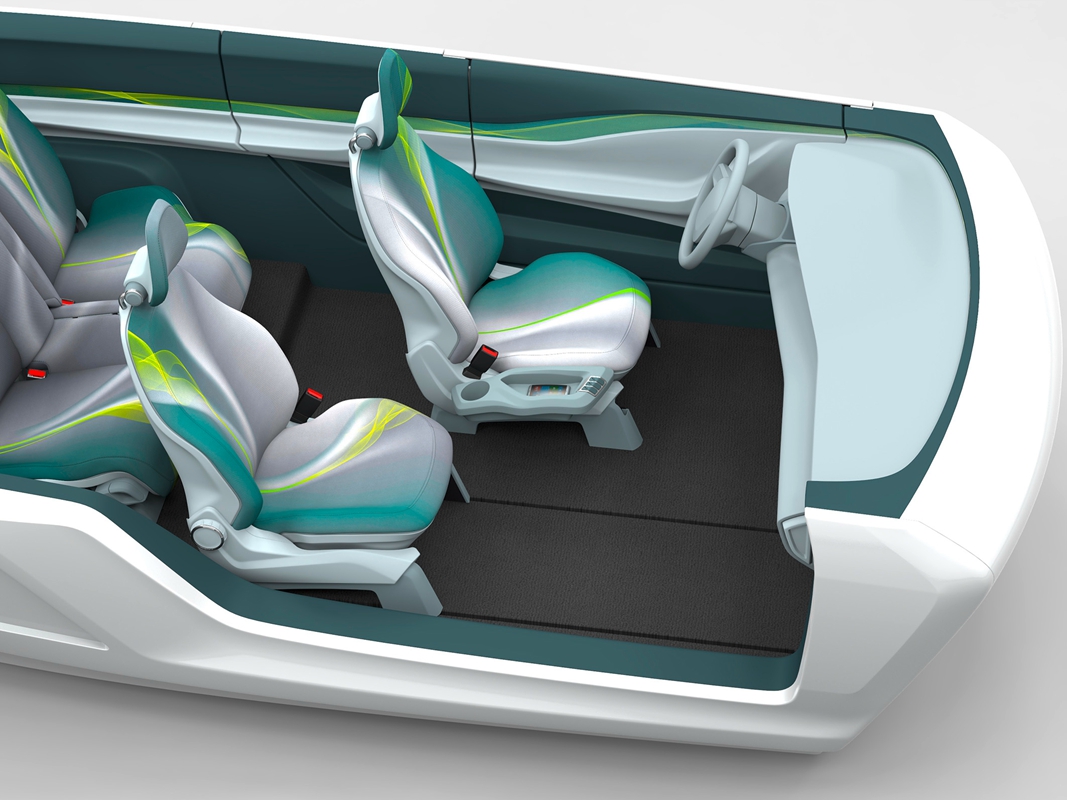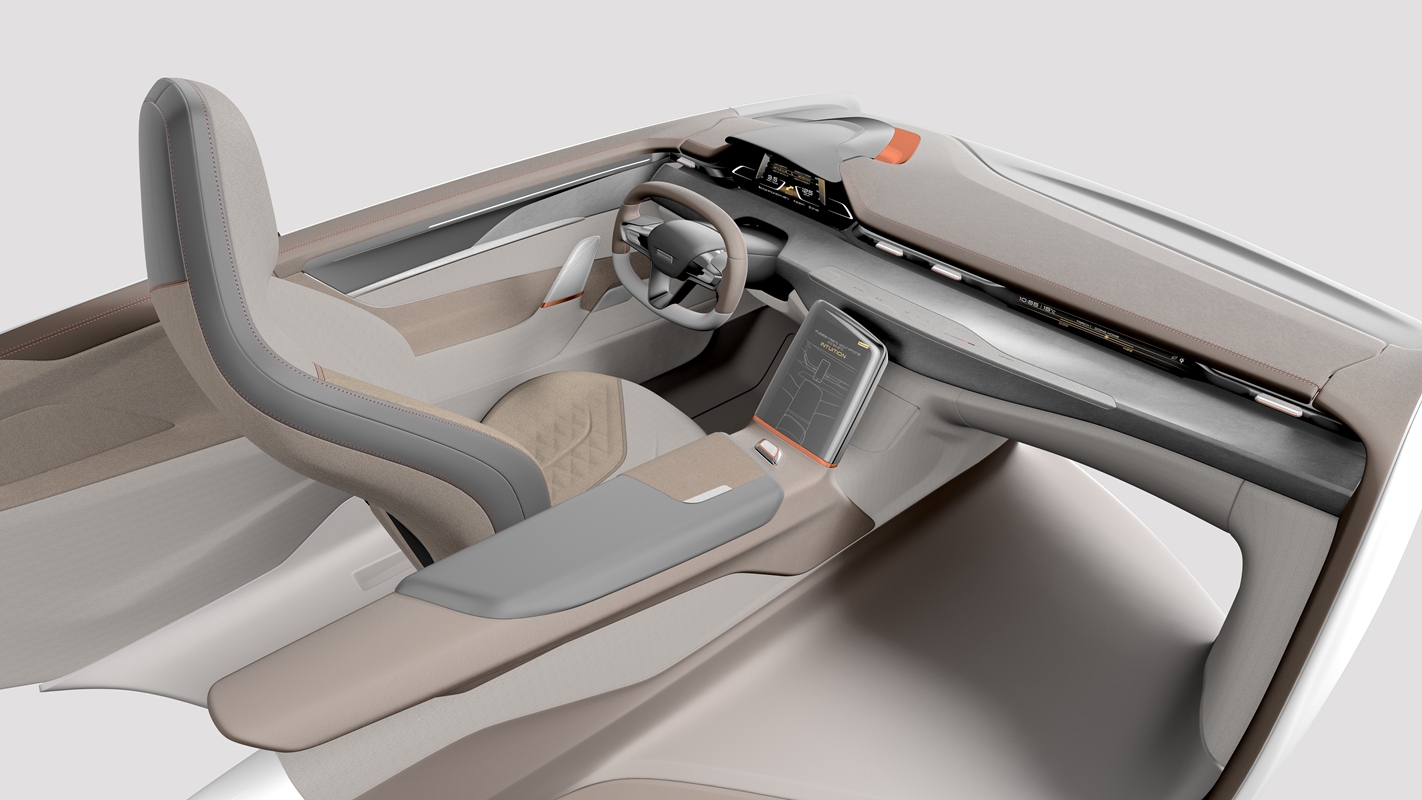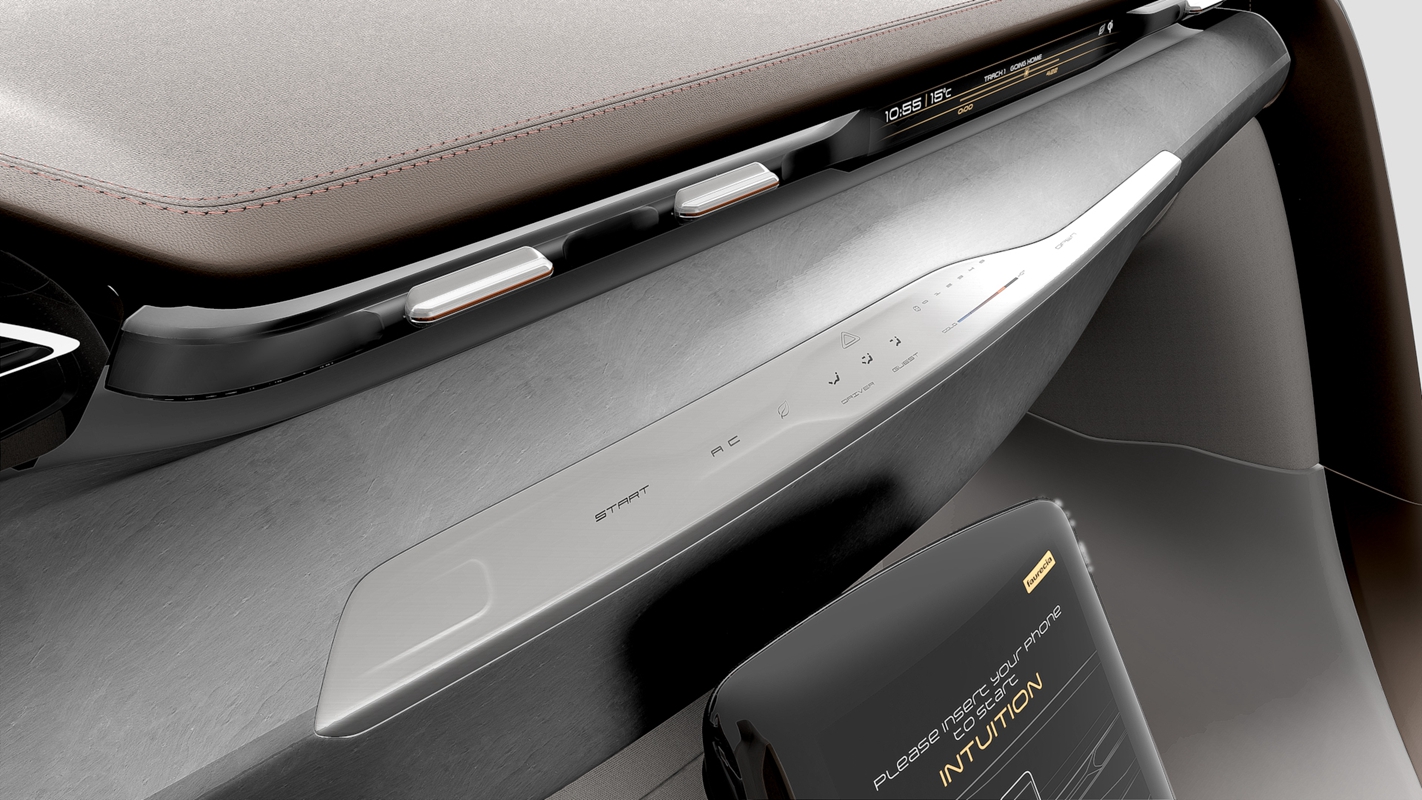 江森自控预测,当辅助驾驶系统出现后,驾驶员座椅将成为一种“舒适的控制设备”。
江森自控预测,当辅助驾驶系统出现后,驾驶员座椅将成为一种“舒适的控制设备”。 “在未来,驾驶座上的人员角色将从一名‘主动的驾驶员’变成一名‘监督人员’,只在必要的时候介入车辆的操纵。” 江森自控的Detlef Jürss博士表示。
“在未来,驾驶座上的人员角色将从一名‘主动的驾驶员’变成一名‘监督人员’,只在必要的时候介入车辆的操纵。” 江森自控的Detlef Jürss博士表示。 江森自控的SD15座椅展示机是一台安装在一段曲线轨道上的电动驾驶座椅,它摈弃了传统座椅中各种分离且复杂的结构,控制杆直接安装在座椅结构上,可随着乘员的移动而移动,此外还能为移动设备充电。
江森自控的SD15座椅展示机是一台安装在一段曲线轨道上的电动驾驶座椅,它摈弃了传统座椅中各种分离且复杂的结构,控制杆直接安装在座椅结构上,可随着乘员的移动而移动,此外还能为移动设备充电。 佛吉亚的Intuition自动驾驶展示机着重强调驾驶员与其他乘员的舒适度与互联网连接需求的满足。
佛吉亚的Intuition自动驾驶展示机着重强调驾驶员与其他乘员的舒适度与互联网连接需求的满足。 Intuition采用了一种名为DecoControl Alu的软质铝合金表面,这是一块同时起到监控和装饰作用的区域,安装于IP的下方,其中还整合了电容开关。还需指出的是,安装在乘客一侧的“隐形”黑色屏幕会在使用模式下亮起。
Intuition采用了一种名为DecoControl Alu的软质铝合金表面,这是一块同时起到监控和装饰作用的区域,安装于IP的下方,其中还整合了电容开关。还需指出的是,安装在乘客一侧的“隐形”黑色屏幕会在使用模式下亮起。
江森自控认为,随着汽车行业朝着自动驾驶的趋势发展,汽车内饰与座椅的要求也将随之“彻底改变”。这家供应商预测,随着新式的辅助驾驶系统的到来,驾驶员的座椅也将变成一个“舒适的控制设备”。在2015年法兰克福车展上,江森自控的主管们就这个即将到来的变革发表了自己的看法。
“自动驾驶时代马上就要来临了,”江森自控集团副总裁兼产品组座椅部件总经理Detlef Jürss表示。“在未来,驾座上的人员角色将从一名‘主动的驾驶员’变成一名‘监督人员’,只在必要的时候介入操纵车辆。而座椅则会变成一个具备多种智能功能的车内部件,可以增加车辆的安全性、舒适性和娱乐性。”
但Jürss也指出,还需要过很长时间才能看到汽车掌握所有控制功能、使驾驶员彻底变成乘客。在这条道路上,首先需要克服的障碍有很多,包括需要花费巨资研发基础建设,厘清法律责任和道德问题(安全系统究竟保护谁?),并解决技术可行性和安全问题等。
“汽车座椅将成为乘员安全保护的重要部件,将和车内所有的主动安全系统紧密相连,” Jürss表示。可以预测,未来的自动驾驶汽车的内饰将会包括一个功能丰富的驾驶员座椅,它不仅能够旋转,使乘员之间可以直接沟通,而且还能让乘员躺下休息。而江森自控认为,若想在这种情况下加强安全措施,座椅部件必须与汽车的整个传感器网络相连,而且必须具备互动功能。
江森自控研发了一款已经获得批准的可折叠、可平躺的后排座椅结构,有点像飞机商务舱的座椅。这款座椅专为一家汽车制造商研发,现在已经开始批量生产了。因为采用了一种可在事故发生时将座椅靠背竖直的传感器技术,该产品符合汽车的安全规范要求。
此外,提升体感和精神上的舒适程度也将成为自动驾驶汽车座椅的重要发展趋势。座椅必须能够对传感器探测到的驾驶员昏沉或紧张状态进行独立反应。比如说,在长时间使用按摩或气动侧枕功能后应自动发出警报或调整乘员姿势。
“未来的座椅必须为被动驾驶员提供所有可能的选项,让他们可以一边前行,一边工作、娱乐和交流。” Jürss举了一些例子,如平板电脑支架、阅读灯和耳机等。“我们还能想象如何将空闲的副驾座变得更灵活,在没人乘坐的时候把它变成移动办公室或休闲区域,并配上一些防滑的储物空间,方便人们放置个人物品、饮料或可在车上无线充电的电子设备。”
江森自控在法兰克福车展上展出的SD15座椅就包含了上述解决方案中的一部分,而且现在已经进入研发阶段。
江森自控不是唯一一家正在猜想未来自动驾驶汽车的内饰会是怎样的公司。同样,在法兰克福车展上,佛吉亚集团在它的Intuition示范机上展示了增强车载联网性能的创新方案。
佛吉亚发现,越来越多的汽车乘员希望车上具备自动化功能,而且还希望对车内功能进行个性化设置,使其能够无碍地与外界连接起来。
“佛吉亚在Intuition上展示的车载联网功能不仅更出色,而且更直观,”佛吉亚客户推广总监Gherardo Corsini表示。“尽管完全自动的汽车还没出现,但我们已经在开发能够实现这一目标的技术了。而现在我们展示的创新技术可让乘客们提前窥见未来车内的景象。”
其中最关键的是能够适应驾驶员情况的主动适应技术。当车辆切换到自动驾驶模式时,Intuition可以提供更大的舒适度。驾驶员可以伸长座椅,进入放松模式,而中控装置则会向后排方向滑动,让驾驶员可以时刻够得着屏幕。当然屏幕的方向也会面朝用户,时刻便于使用。
车内环境也可以根据驾驶情形而改变。比如说,当车辆处于“部分放手模式”,且驾座处于“放松”位置的时候,内部照明会自动改变成更柔和的模式。
此外,佛吉亚的设计研究还偏重于个人电子设备的整合。智能手机和平板电脑上的内容可以投射到中控台的触屏上,让乘员能够使用移动设备上的功能。使用感应技术的无线充电设施则位于侧门、手套箱和中控台等位置。
Intuition概念机的另一项创新功能,是一个用“智能的”装饰性铝合金表面构成的触摸式仪表板,用接触式的、一体化的电容式开关来替代传统的控制设备。细微的振动和照明即可触发各种功能的开启。佛吉亚表示未来还将在概念机和产品上使用这一技术与其他类型的“信息皮肤(infoskin)”。这个名为DecoControl Alu的产品将有望在2018年推出的车型上首次亮相。
此外,佛吉亚展出的创新技术中还包括隐形屏幕和高分辨率屏幕。该公司研发了一种黑屏技术,并将其与前座乘员前方的仪表板整合在一起。在非主动状态下,这块屏幕是看不见的,只有在使用状态中才会亮起。位于中控台的这块高精度曲线屏幕不仅具有超高的画面解析度,而且封装也非常方便。
佛吉亚表示,Intuition及其中的各种功能都已经为汽车制造商的新产品开发做好了准备。该公司预测,在2020年的汽车中就能看到这些设计和功能了,因为那时候将是自动驾驶汽车发展的高峰。
作者:Ryan Gehm
来源:SAE 《汽车工程杂志》
翻译:SAE上海办公室
原标题:Johnson Controls, Faurecia envision interiors for autonomous driving
Johnson Controls, Faurecia envision interiors for autonomous driving
As the automotive industry moves to more autonomous driving, the requirements for vehicle interiors and seating will “radically change” as well, according to Johnson Controls. The supplier foresees the driver’s seat becoming a “comfortable control unit” as additional assistance systems come on board. Company executives shared their vision of the forthcoming shift at the recent IAA (Frankfurt Motor Show) 2015.
“Autonomous driving is on its way,” said Dr. Detlef Jürss, Group Vice President and General Manager Product Group Seating Components at Johnson Controls. “In the future, the role of the person in the driver’s seat will shift from that of an ‘active driver’ to that of a ‘supervisor’ who must be able to intervene whenever necessary. The seat will become a multi-talented interior component that provides its strengths in safety, comfort, and entertainment.”
But it’s still a long way off until the vehicle takes over all control functions and the driver simply assumes the role of passenger, according to Jürss. Challenges that must first be overcome include details concerning the necessary investment-intensive infrastructure, liability and legal issues, ethical aspects (who do the safety systems protect?), technological feasibility, and safety.
“The seat will become much more of an integral part of occupant protection, which will be linked with all active safety systems within the vehicle,” said Jürss. Anticipated features of autonomous-vehicle interiors include a driver’s seat that can rotate to allow direct communication among passengers, or fully recline to a resting position. To enhance safety in such situations, seating components will be linked to the vehicle’s entire network of sensors and be capable of interaction, according to Johnson Controls.
The supplier already has developed the first approved fold-flat rear seat structure—similar to a business class seat on an aircraft—for an automaker and is bringing it to series production. The product complies with automotive safety regulations thanks to sensor technology that raises the seat to an upright position in the event of a crash.
Increasing comfort and well-being is another major focus for seating in autonomous vehicles. The seat must be able to react independently to sensor-based evidence of drowsiness or tension—for example, with an automated alarm or position adjustments over longer distances such as a massage function or pneumatic side bolsters.
“The seats of the future must offer the occupant, as a passive driver, all possible options for work, entertainment, and communication while traveling,” said Jürss, citing the integration of tablet holders, reading lights, and headphones as examples. “We can also envisage making the unused front passenger seat more flexible, turning it into an additional mobile office or living space when unoccupied, and offering non-slip compartments for personal items, drinks, or electronic devices, which can also be charged wirelessly.”
The supplier’s SD15 seating demonstrator at Frankfurt showcased some of these solutions, which are already under development.
Johnson Controls is not alone in addressing what the interiors of autonomous vehicles might look like. Faurecia revealed at the Frankfurt Motor Show its Intuition demonstrator comprised of innovations enhancing onboard connectivity.
Faurecia already is finding that vehicle occupants want more autonomy and more opportunities to personalize their interior with seamless connectivity to the outside world.
“With Intuition, Faurecia is bringing not only better, but more intuitive, connectivity on-board vehicles,” said Gherardo Corsini, Customer Marketing Director, Faurecia. “Though we’ve not yet seen fully autonomous cars, we’re starting to develop the technologies needed to bring them to the road while offering passengers a preview of the innovations that will be part and parcel of the vehicle cabin of the future.”
Automatic adaptability to the driver’s situation is key. When a vehicle transitions to an autonomous mode, Intuition offers more comfort. Drivers can elongate their seat to relaxed mode while the center console slides back so the screen is always within reach. The screen also pivots toward the user for ease-of-use.
The ambience of the vehicle cabin also can adapt to the situation. For example, when the vehicle is in “partial hands-free mode” and the driver’s seat is in the “relax” position, interior light settings can automatically change to provide a more soothing environment.
The design study also emphasizes the integration of personal electronic devices. Smartphone and tablet screens can be projected onto the center console’s touchscreen to provide vehicle occupants access to mobile functionalities. Wireless charging stations, using induction technology, are located in the side doors, the glovebox, and the center console.
Another innovative feature of the Intuition concept is a “smart” decorative aluminum surface that forms a tactile dashboard, replacing traditional controls with touch-sensitive, integrated capacitive switches. Slight vibration and illumination are used to signal actions. Faurecia says it will increasingly employ this and other types of “infoskin” for switchless controls in its concepts and products. DecoControl Alu, as it’s called, is expected to first appear on 2018 model year vehicles.
Invisible screens and high-definition screens are also incorporated. The supplier has developed black panel technology that’s integrated with the instrument panel facing the front passenger. The screen remains invisible when not active, lighting up when in use. Located on the center console, high-definition, curved screens offer high image resolution and packaging freedom.
Intuition and all its features are ready for program development with automakers, Faurecia claims. The supplier foresees such designs and functionality inside the vehicles of 2020 and beyond—at the midpoint in the evolution of autonomous cars.
Author: Ryan Gehm
Source: SAE Automtoive Engineering Magazine
等级
打分
- 2分
- 4分
- 6分
- 8分
- 10分
平均分
